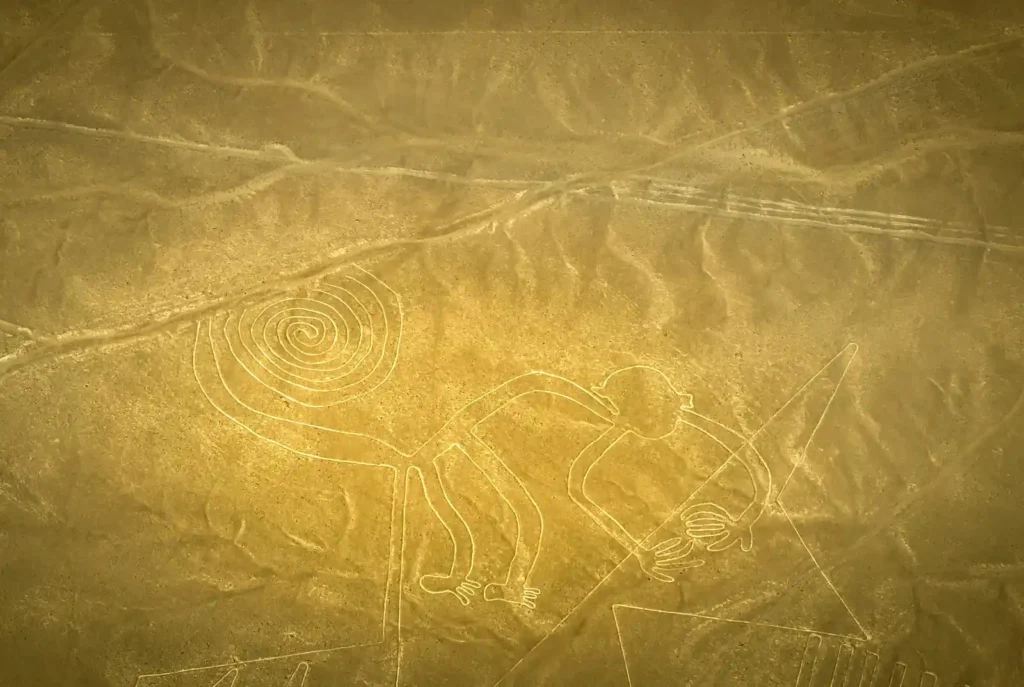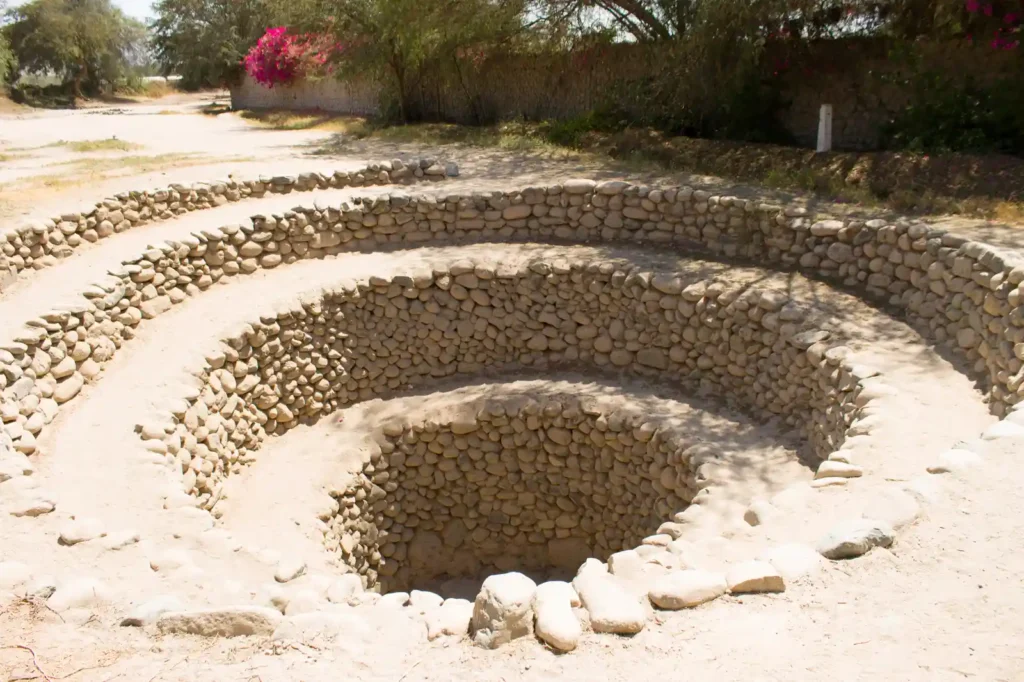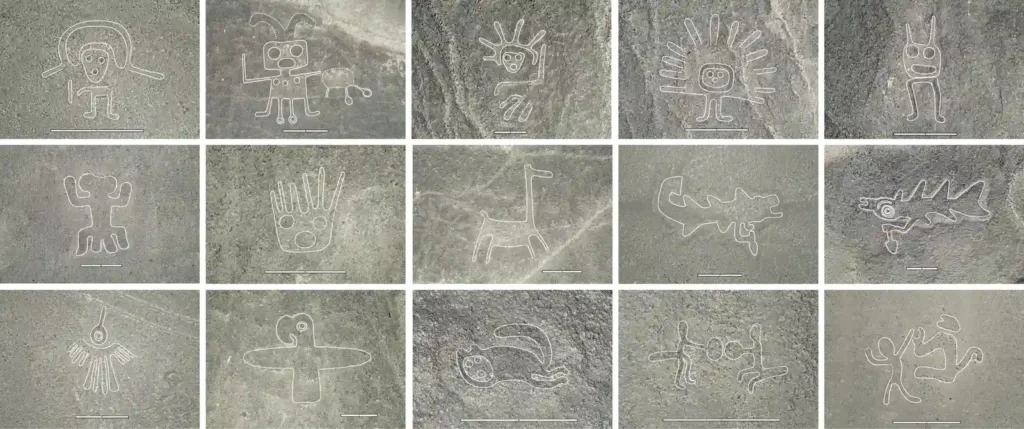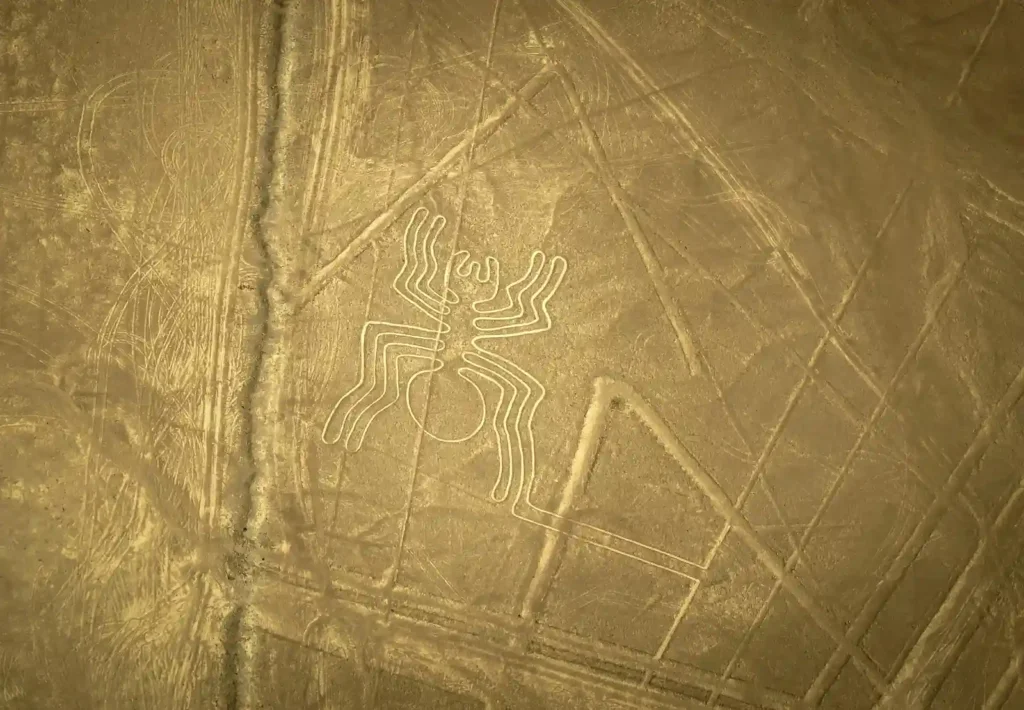A desert that reveals the unseen
Imagine flying over a vast, silent desert and suddenly spotting a perfectly drawn hummingbird nearly 100 meters long etched into the ground. Or a monkey with a spiral tail, a stylized dog, or a condor with outstretched wings — all only visible from above. That’s how the Nazca Lines in Peru were unveiled to the world: immense, precise figures traced across the southern desert, nestled between arid valleys and silent mountains.
For centuries, no one saw them in full. While local communities were aware of strange marks on the ground, it wasn’t until the 20th century, with the arrival of commercial flights over the area, that the drawings were seen at scale. Even more surprising: many of them are over two thousand years old.
Who created them? For what purpose? And more astonishingly — how have these lines remained intact, resisting time, wind, and forgetfulness?
What first seemed like an archaeological curiosity slowly turned into one of humanity’s most enduring enigmas. Even today, with the help of drones, satellites, and artificial intelligence, no one has fully explained the mystery of the Nazca Lines in Peru.
Explore also:
What are the Nazca Lines?

The Nazca people created the iconic Monkey geoglyph, with its spiral tail stretching nearly 93 meters across. Since it can only be fully seen from above, its creation and purpose continue to intrigue archaeologists. Image via Pexels – free use.
A desert turned into canvas
The Nazca Lines are located in an arid plain in southern Peru, about 400 km south of Lima. They cover roughly 450 km² in a region so dry it almost never rains — a factor that helped preserve the figures for centuries.
These lines were created between 500 BCE and 500 CE by pre-Inca cultures, particularly the Paracas and Nazca. To draw them, the creators removed the top layer of dark rocks — coated with iron oxide — revealing the lighter soil beneath. This contrast is what created the visible patterns that, remarkably, are still seen today.
There are over 800 straight lines, 300 geometric shapes, and around 70 biomorphic figures, including animals, plants, and human forms. Some lines stretch over 10 kilometers, and some figures exceed 100 meters in length.
Art, ritual, or language?
No one knows for sure why the lines were made, but one thing is clear: these massive designs were not mere decorations. Their complexity and precision suggest ritualistic, symbolic, or social purposes that remain under debate.
Among the most accepted theories is that the lines served as ceremonial paths, symbols of devotion, or a way to communicate with deities — especially water gods. In a region dominated by drought, rainfall may have been the deepest collective desire.

The Cantalloc Aqueduct in Nazca shows that the Nazca Lines are not the only remarkable legacy of the civilization that lived there. In addition to the geoglyphs, structures like this one reveal the Nazca people’s impressive mastery of irrigation despite the extreme desert conditions. Photo by Kevo287, via Wikimedia Commons, licensed under CC BY-SA 4.0.
A mystery unveiled from above
The flight that changed everything
It wasn’t until the 1920s that the Nazca Lines began gaining international attention. At the time, commercial pilots flying over the region noticed the massive designs on the ground.
Years later, in 1941, American historian Paul Kosok flew over the area and famously described the lines as “the largest astronomy book in the world.”
Then came María Reiche, a German-Peruvian mathematician and archaeologist, who dedicated her life to measuring, mapping, and protecting the lines. According to her, the drawings functioned as an astronomical calendar, with alignments marking solstices and key celestial events for agriculture.
Thanks to her tireless work, the world began to take the Nazca Lines in Peru seriously. As a result, UNESCO declared the site a World Heritage Site in 1994.
Between star maps and water rituals
While the astronomical theory popularized by Reiche gained traction, recent studies have expanded the debate about the true meaning of the Nazca Lines in Peru. Remains of marine shells and fertility-related symbols suggest that the lines may have been part of rituals connected to water and fertility — vital in one of the driest places on Earth.
Other theories propose that the lines marked underground water routes or served to reinforce cultural identity among different clans.
Naturally, speculative theories also emerged: from alien landing strips to interplanetary messages. However, none of these ideas are supported by solid archaeological evidence.
AI-powered discoveries

New Nazca geoglyphs discovered with the help of artificial intelligence. The image shows 15 of the 303 newly identified figurative geoglyphs, including human shapes, animals, and ceremonial scenes. White outlines were added for visualization. Credits: Sakai et al. (2024) – Proceedings of the National Academy of Sciences (PNAS).
The desert still speaks
Nazca’s landscape continues to reveal secrets. In 2018, drones uncovered around 140 new figures in the Palpa region, near Nazca — many smaller than those previously known.
But the biggest breakthrough came in 2024, when an AI system developed by Yamagata University in Japan identified over 300 new geoglyphs in satellite imagery. These include stylized humans, felines, birds, and everyday scenes drawn by the Nazca culture.
These discoveries show that the Nazca Lines are not an isolated mystery: they are part of a much broader symbolic and ritual network that spans cultures predating and following the Nazca.
Why do they remain a mystery?

The Nazca people drew the Spider geoglyph with incredible precision. At first glance it seems simple, but its impressive symmetry only becomes evident from above. Image via Pexels – free use.
When knowledge is not enough
Even with all our technological advances, we still don’t have a definitive answer to what the Nazca Lines truly represent. After all, they were not made to be seen from the ground — a fact that defies conventional logic. Some are so perfectly proportioned that they suggest refined mathematical planning.
There’s also a constant tension between science and popular imagination. Conspiracy theories persist, fueled by sensational documentaries and YouTube videos. Science progresses, but the allure of the unknown remains intact.
Perhaps that’s what makes the Nazca Lines in Peru so compelling: the sense that something essential is still missing from our understanding.
A call for preservation
Threats from modern times
In 2025, a proposal to reduce the protected area around the lines sparked international protests. The risk? Mining companies and agricultural expansion encroaching on land that may still hold undocumented figures.
Uncontrolled tourism also poses a threat. Some visitors walk or drive over the lines, leaving irreversible damage. The Peruvian government has even reported cases of vandalism, including heavy machinery rolling over ancient drawings.
To preserve the Nazca Lines is not just to protect the past — it’s to ensure that the mystery continues to inspire the future.
Conclusion: a desert that defies time
The Nazca Lines in Peru are more than prehistoric art. They are an ancient code still without translation. A plea for rain, a tribute to the skies, a cultural signature, an invisible path between the earthly and the spiritual — or perhaps all of this at once.
What remains clear is that there’s wisdom in them, even if wrapped in silence. And that silence, etched into the desert floor, may be the most powerful part of the mystery.
References
Posts Recomendados
Carregando recomendações...



